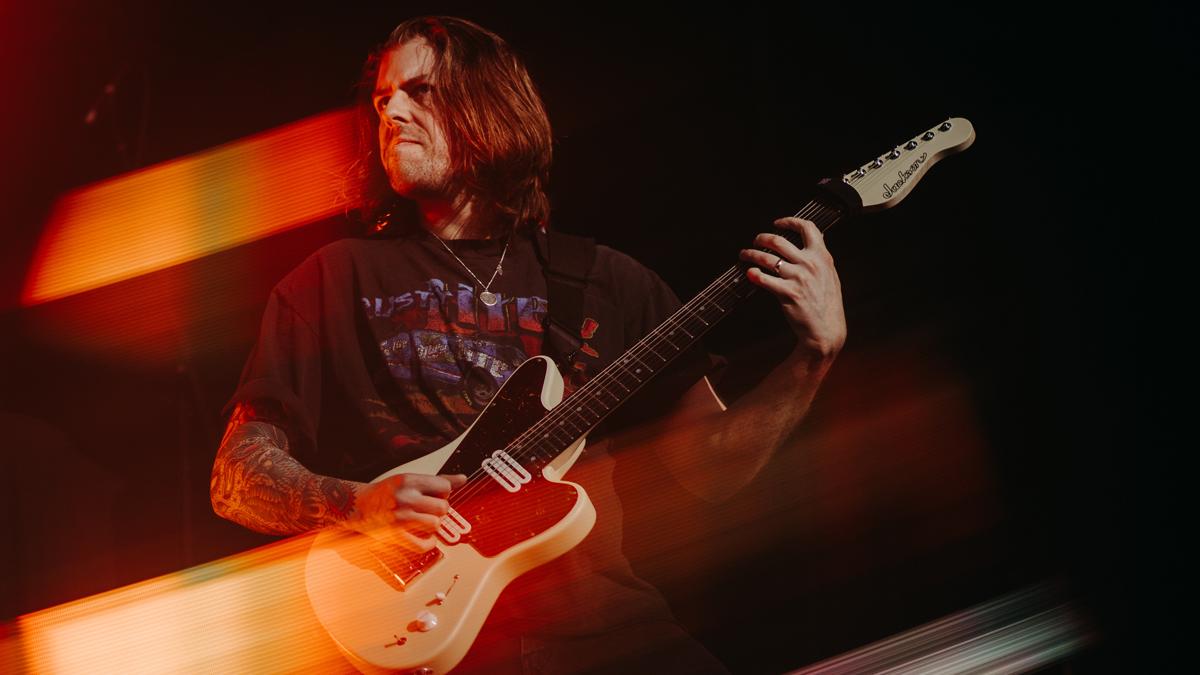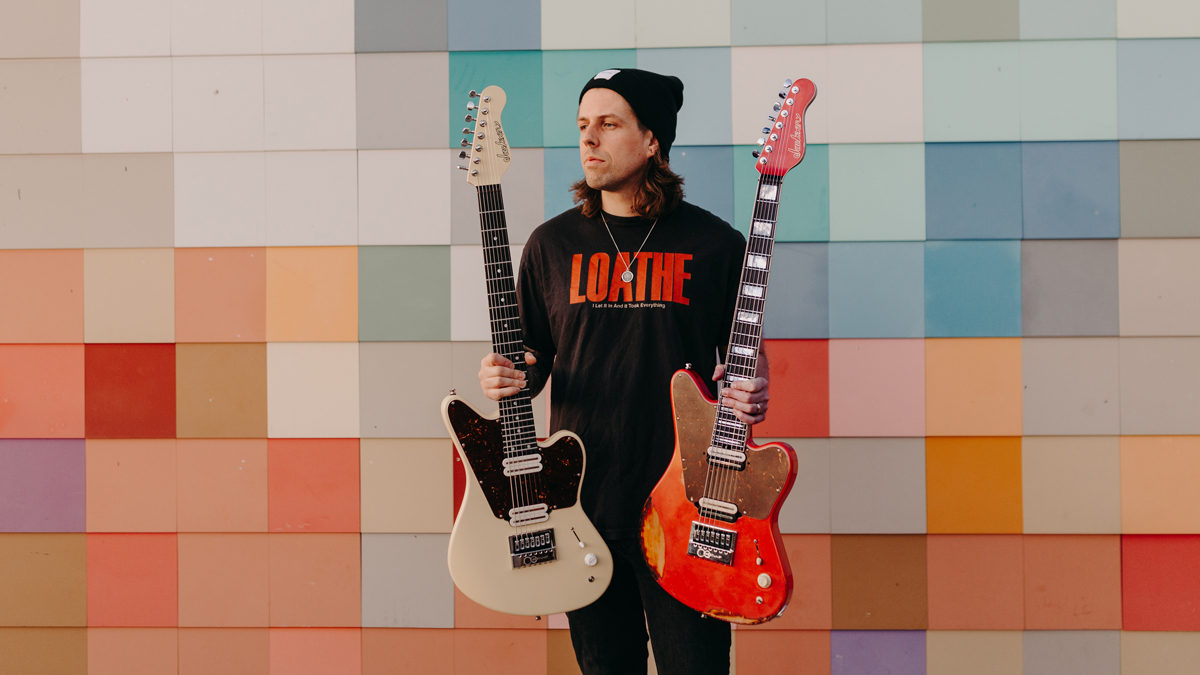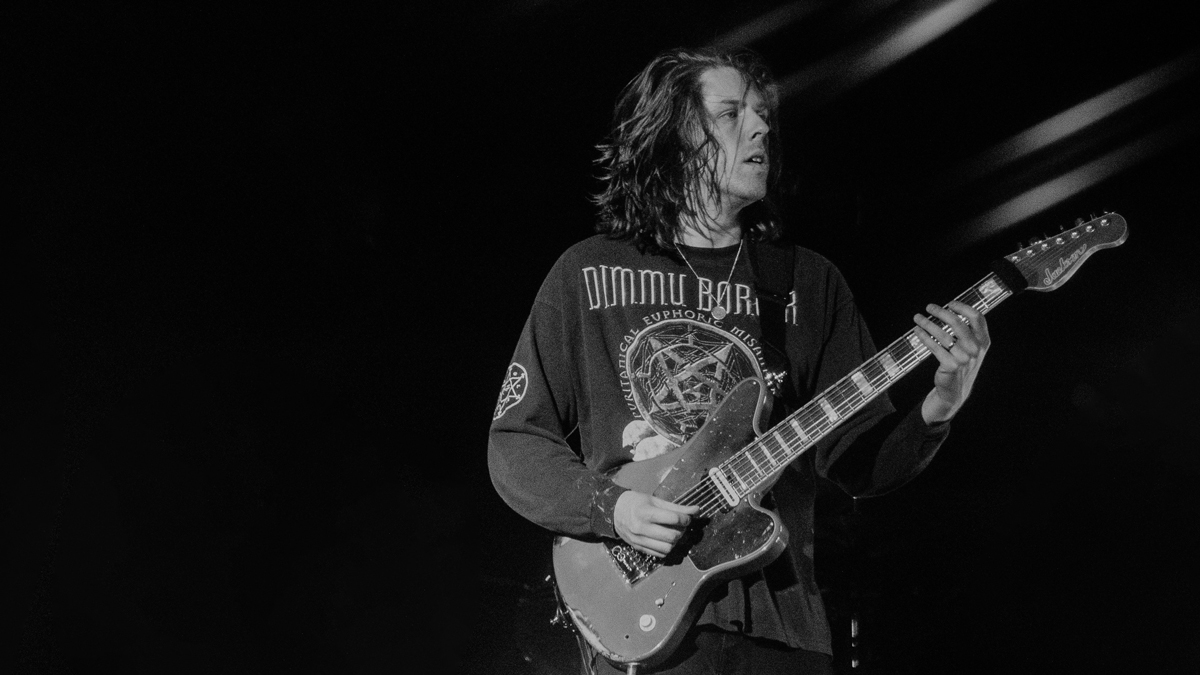“My goal was to make a modern, metal take on a vintage Jazzmaster shape… I never thought the first track I would use it on would be with Megan Thee Stallion”: Spiritbox’s Mike Stringer on 2023’s most talked-about offsets – and the collab no-one saw coming
Recently nominated for a Grammy, Spiritbox are now one of modern metal’s biggest success stories. Their production-savvy guitarist details how he tackled their viral hip-hop crossover, why bridges are key to his unique tracking approach, and the fervor surrounding his custom Jackson Surfcasters

Spiritbox guitarist Mike Stringer has had the metal guitar community salivating throughout the fall. You can chalk some of that up to how the Vancouver Island-formed, California-based combo just dropped The Fear of Fear, a juddering, progressive-but-pop-friendly next step from 2021 breakthrough Eternal Blue.
Standout single Jaded – a veritable sizzle reel of Stringer’s pedal-based loop work, syncopated chunking, and anthemic finesse – amazingly nabbed the band their first Grammy nomination.
What’s also got seven-stringers sweating, though, is the pair of customized Jackson Surfcasters Stringer recently unveiled over Instagram. It’s a wild look, with the classic offset-style body jazzed up for djenters via its extra string, a wire-wound set of Fishman Modern Open Core humbuckers, and an EverTune bridge – key components to Spiritbox’s drop F# plunging tones, Stringer explains.
While modernized for metal players, the guitarist is still drawn to the Surfcaster’s retro aesthetic. “You know when you go into a really great vintage guitar shop and you see all those top-shelf guitars that look like they’ve been through hell and back?” Stringer asks.
“You always want to know what the story is there. I wanted that right off the bat with the Fiesta Red Surfcaster,” he adds of the road-worn finish Jackson brought to one of his customs.
Turns out that Surfcaster already has a hell of a story up its sleeve – namely that its first-ever studio performance ended up being the riff-fest supporting Megan Thee Stallion for their recent Cobra (Rock Remix) collaboration.
In late October, the rap star drafted Stringer and Spiritbox co-founder/vocalist Courtney LaPlante into one of the most unique rap/metal mashups ever – pairing her bars with dexterously percussive low-string manipulations and LaPlante’s patented swirl of screamed-and-sung vocals. Also unique for Spiritbox was how their contribution came together in a 48-hour window, from initial riffing to release.
Get The Pick Newsletter
All the latest guitar news, interviews, lessons, reviews, deals and more, direct to your inbox!
From the season’s sickest rap/metal crossover to the Grammy nod, to whether or not his Surfcasters will make it to market, Stringer takes Guitar World through Spiritbox’s action-packed back-half of 2023.
How did you end up getting set up with those Jacksons?
“I started working with Jackson the last time we played Download Festival, which was 2022. I’ve always had a crazy fixation with old-school offset guitars. My goal was basically to make a modern, metal take on a vintage Jazzmaster shape. Jackson were really happy to do it. They pulled out the Surfcaster model and were like, ‘How do you feel about this?’ It blew me away.
“Over the course of the last year, it went back and forth on different renders and colors. It was very important that at least one of them was relic’d, or pretty beat-up looking – I’m such a sucker for something that looks like a pawn shop vintage.
“At this point, it’s been a couple of months since I got them, and I can’t put them down. They cover every base that I need them to cover, and they play so well. Every time I look at them it makes me smile. They’re the only ones in existence! It’s such an honor to have them.”
It’s things you would see in a much pointier metal guitar, but it’s a classic, familiar shape… it’s cool to look at an offset like that and think, ‘What would that look like for a player that tunes in drop F#?’
What exactly did it mean to modernize that kind of offset?
“From being a metal guy, and from speaking to other metal players, I was like, ‘I wish a brand would do an offset with an EverTune. Like a seven-string that’s extended scale.’ So I took everything that I need to play our music optimally and put it on this guitar.
“We went with a 26 ½ inch scale, so it’s a little longer than the standard scale guitar. We slapped an EverTune on it – it’s no secret that I very much enjoy the EverTune. We put Fishman Modern Open Core pickups in there. We threw in a split-coil tap on the bottom.
“It’s things you would see in a much pointier metal guitar, but it’s a classic, familiar shape. I just think it’s cool to look at an offset like that and think, ‘What would that look like for a player that tunes in drop F#?’ I think we landed on that; they crushed it.”

How does it feel to have a Grammy nomination for a melodic, but still progressively techy song like Jaded?
“Jaded is a song that came about in a day. I wrote it in a spur-of-the-moment situation. It’s funny, because when we finished the EP and we showed it to the powers that be, everybody pointed at Jaded and said, ‘This is the one.’ But me and Courtney were like, ‘You’re way off.’ Because it came about so quick, I thought, ‘There’s no way it could be so good.’ Your brain plays tricks on you, essentially.
“When it came to the Grammy submissions, we didn’t even set alarms for the nomination day. We were already on cloud nine from the collaboration with Megan Thee Stallion, which came about that same week.
“That week was already so stressful, but also such a dopamine release of craziness, that when [the nomination] happened, I just stared at the ground for 25 minutes in complete disbelief! I’m so honored and ecstatic that they recognized that particular song, because it is a little more progressive, more of a return to our roots.”
Getting into the collaboration, there’s something we’re hoping you can confirm for us: is this the only Megan Thee Stallion song in drop F#?
“You know, when I really think about it, I think it is!”
How did you end up connecting with her for the remix?
“About a week before [the original version of] Cobra came out, her team reached out to see if we would be interested in working on one of her new songs. They weren’t able to send us the stems until the song was released, which coincidentally was the same day that our EP came out.
“I remember sitting in my living room thinking, ‘We should probably listen to that Megan song and see what’s up with it,’ so we put it on that night and thought it was extremely dark and different for her. A lightbulb went off in my brain: ‘I actually hear how we can go about this!’ – but the problem was that I still didn’t have the stems.
“Before that, I was actually listening to Jay Z and Linkin Park [who released collaborative album Collision Course in 2004] to kind of get that vibe of rapping with heavier music. I love that collaboration; it’s a classic.
That was the quickest turnaround I’ve ever been a part of, and it was such an incredible experience to get a sense of how artists of that caliber operate
“Then one Monday morning I woke up to a WeTransfer link, so I immediately ran into my studio and started working on [the stems]. I want to say about six hours later, [management] were behind the scenes discussing if we had anything to present yet. But I was like, ‘I really need 24 hours, please.’
“The long story short is that by Tuesday night it was submitted, they worked on the artwork and visualizer around the clock, and by Wednesday afternoon it was out. That was the quickest turnaround I’ve ever been a part of, and it was such an incredible experience to get a sense of how artists of that caliber operate.
“I’m very appreciative of Megan. She really got [what we did] and she didn’t have any critiques. The fact is that we had only included Courtney’s singing part at the very end, but Megan actually wanted more of Courtney on the chorus, which was awesome! It was quite an honor. I love that Megan was super-down with the heavy bits. She seemed extremely stoked.”
Thinking about the timing of things, was this the first track to feature one of those Jacksons?
“It actually was. I layered with it; I did do some rhythms with it as well. It’s crazy to think about that. I never thought that one of the first tracks I was going to use this for would be with Megan Thee Stallion. I thought it’d be some demo.”
Getting back to The Fear of Fear, did you approach your guitar texturing any differently on this EP any than you had on Eternal Blue?
“That was one aspect of it that I really wanted to nerd out on. I actually purchased a couple of pedals; one of them was the Hologram Electronics Microcosm. We also got a BigSky from Strymon.
“To be honest with you, I was missing the vibe that we had at the beginning of our career. The first EP [2017’s Spiritbox] was very bleak; very dark. I think a lot of that had to do with the layers of ambiance. So, we got to really experiment and have a lot of fun with effects and layering [on The Fear of Fear].
“It got to the point where I was recording parts with reverb and my usual chains, then we were printing them, sending them out of the interface into the Microcosm, and looping them back into the interface.
“The beauty of that pedal is that it rarely does the same thing twice – you know how it goes when you mess with delay time knobs and you get a warped, weird thing. We did that a lot with this pedal. It’s the heart of the sound on this EP.
“The best way that I can describe it is that I really want the listener to feel like they’re being hypnotized by the ambiance. I want them to recognize that there’s a lot going on. I don’t shy away from the fact that we use a lot of layering and a lot of guitar tracks; it makes it more immersive. We live in a time where its easy to record, so why not make it as dense, pretty, or as heavy-sounding as possible? You can do that with these pedals.”
You recently had a conversation with a fan on Instagram noting how you’ll often switch between EverTune and traditional fixed bridges within the same Spiritbox song. What’s your philosophy around this?
“The way I approach it is I’ll do a left-and-right with an EverTune, and then I’ll do a left-and-right with a fixed bridge. You get part of the sound from the heaviness of being in that low tuning… of course you want control, but you also want to hear that slight, out-of-tune bend on the heavy bits, right?
“Now, the EverTune is incredible, but the whole point of that thing is it locks you in; it makes it so you don’t have to worry about tuning. But within the genre – for example, we have a part in a song called Angel Eyes – when the breakdown hits, you hear the note move and come back. So what we’ll do is we will go through the song after both ways are tracked and we’ll just piece it together. It is nice to have both sides of it.”

Bringing it back to those Surfcasters, people really embraced them as soon as you posted them online. Periphery’s Misha Mansoor said he wants one of those, stat. Surely he can’t be the only one. Are you testing the waters with a signature?
“It was very overwhelming to post about them and see the response. It kind of proves that I’m not the only one sitting around thinking about the potential of what this model can be. And I love Misha – he’s a good friend of mine. He actually came over and played these, and he loved them.
“I’m not sure what’s going to happen – I’m just happy that people even care about them, because they are a little out-there. There’s nothing official happening with Jackson. I’m going to take them on the road; I’m going to record with them to see what I love or don’t love. Right now, I’m lovin’ them.”
- The Fear of Fear is out now.
Gregory Adams is a Vancouver-based arts reporter. From metal legends to emerging pop icons to the best of the basement circuit, he’s interviewed musicians across countless genres for nearly two decades, most recently with Guitar World, Bass Player, Revolver, and more – as well as through his independent newsletter, Gut Feeling. This all still blows his mind. He’s a guitar player, generally bouncing hardcore riffs off his ’52 Tele reissue and a dinged-up SG.
“I heard the Money solo and thought, ‘This is amazing!’ So I sent David a telegram saying, ‘Remember me? I'm in a band now called Roxy Music’”: Phil Manzanera on his friendship with David Gilmour, and the key to the Pink Floyd man's unmistakable tone
“It’s really quite genius, but also hard to learn – it sounds insane, but sometimes the easiest songs still get me nervous”: Kiki Wong reveals the Smashing Pumpkins song she had the most trouble with











